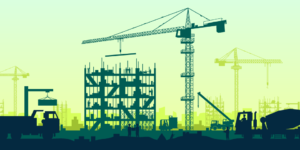High-rise real estate development, or the construction of tall, multi-story buildings that rise above the average structure height in the surrounding area, remains a popular asset class for urban developers. Populations in cities and metropolitan areas are projected to grow exponentially in the coming decades, and in order to meet demand for housing and other living necessities, some developers are opting to build upward.
 The benefits of high-rise development are numerous, as tall buildings make efficient use of limited urban space, combating urban sprawl and helping meet demand for housing, commercial, or office space in high-density areas. However, the construction process can also be complex, and developers should be prepared for zoning or regulatory obstacles, potential financial or legal pitfalls, and a longer construction process with more risk and upkeep.
The benefits of high-rise development are numerous, as tall buildings make efficient use of limited urban space, combating urban sprawl and helping meet demand for housing, commercial, or office space in high-density areas. However, the construction process can also be complex, and developers should be prepared for zoning or regulatory obstacles, potential financial or legal pitfalls, and a longer construction process with more risk and upkeep.
Developers should be informed about the advantages of pursuing high-rise real estate development, from efficient land use to mixed-use property potential, as well as the drawbacks of the practice, including regulatory and financial obstacles or high costs.
Understanding the common pain points in high-rise real estate development, and how to solve them, can help teams pursue ambitious, large-scale projects without risking budget overruns or project timeline disruptions.
The Benefits of High-Rise Real Estate Development
 In the United States, the urban population increased 6.4% between 2010 and 2020, and urban areas, defined as densely developed residential, commercial, or other non-residential areas, now account for 80% of the U.S. population. Urbanization in the United States is indicative of a larger global phenomenon, with 80% of the global population expected to live in cities by 2050 as well. Demographic trends toward cities mean urban planners, government officials, and developers are looking for solutions to meet housing needs without contributing to urban sprawl.
In the United States, the urban population increased 6.4% between 2010 and 2020, and urban areas, defined as densely developed residential, commercial, or other non-residential areas, now account for 80% of the U.S. population. Urbanization in the United States is indicative of a larger global phenomenon, with 80% of the global population expected to live in cities by 2050 as well. Demographic trends toward cities mean urban planners, government officials, and developers are looking for solutions to meet housing needs without contributing to urban sprawl.
The “Going Vertical” trend in urban real estate development is the idea that high-rise buildings will help address dramatic urbanization in the coming years, creating high-density mixed-use spaces for residents to live, work, and socialize. Cities have many reasons to embrace tall building typography, including land prices or scarcity, demographic change, globalization, urban regeneration, agglomeration, land preservation, existing infrastructure, and proximity to transportation. Endeavors to expand cities upward can be sustainable and profitable for real estate developers, helping meet housing demand in growing markets and diversify asset portfolios.
Here are a few of the main benefits of pursuing a high-rise real estate development project:

Efficient Land Use. Urban sprawl is a development pattern with a negative impact on human health and the environment, increasing use of automobiles and greenhouse gas. In contrast, densely populated cities are facing a scarcity of land to build or develop on, contributing to housing shortages. High-rise buildings make efficient use of land and will often align with a Smart Growth development pattern, a policy trend that encourages buildings with the potential to promote high-density, mixed-use, and walkable neighborhoods.
High-Density. Beginning in the 1990s, many cities began to shift zoning laws to promote high-density projects to fight urban sprawl and be more climate friendly. In addition to aligning with this policy vision, the high-density potential of tall building projects means developers can expect to create residential or commercial units per plot, resulting in higher returns.
Urban Appeal. High-rise buildings are attractive to residents looking for a specific urban experience, such as millennial or Gen-Z renters, who are gravitating toward city living instead of single-family suburban homes. The mixed-use development potential of high-rise buildings offer the chance to cater even more to such a demographic, boosting urban appeal with additional amenities and access to additional community or socialization opportunities.
Successful high-rise real estate development has been documented around the world. One University Circle in Cleveland, Ohio, is an example of a mixed-use, sustainable high-rise development in a major metropolitan area. The building, which was Cleveland’s first new high-rise development since the 1970s, offers retail amenities on the ground floor and additional amenities for residents. Government officials were eager to greenlight the project given the tight housing market in Downtown Cleveland and the need to meet residential needs without sprawl.
On a larger scale, the Shard in London, England, is a 72-story mixed-use skyscraper that forms part of the Shard Development, conceived as a “vertical city” for residents to live, work, and relax. The building is centrally located near public transit and contains offices, restaurants, the Shangri La Hotel, residences, and a viewing gallery open to the public with a 360-degree view. In addition to providing walkable living and commercial space, the viewing deck at the summit is a popular tourist destination, driving further revenue to the city. Hudson Yards, the ambitious mixed-use development project in New York City, features several high-rise buildings, including the 940-foot office tower at 3 Hudson Boulevard and the residential skyscraper at 15 Hudson Yards. Similar to the Shard, the development is a destination for visitors to the city and offers a variety of retail or recreational amenities to the community at large.

The Drawbacks of High-Rise Real Estate Development
While the size and scope of high-rise real estate development offer many benefits, the complex, ambitious nature of a tall building project also poses unique challenges in the development process. Before undertaking a high-rise project, developers should note the potential for higher construction costs, zoning challenges, and added market risk.
Here are a few drawbacks to high-rise real estate development your team should understand before moving forward with a project of this size:
High Construction and Maintenance Costs
High-rise buildings will have steep construction costs at every step of the process since taller buildings require thicker materials, such as concrete or steel, to build the superstructure on the lower floors and have more costly foundations in order to support the height. Elevators, which may require an additional shaft depending on building height, also increase expenses.
The current economy is creating a scenario where construction costs are already high due to supply chain issues, labor, and commodity costs. Developers might want to consider whether the financial investment a high-rise requires is the most sensible undertaking at the current moment. Current real estate development software can help teams create more accurate budget projections in the early planning phase, decreasing risk and boosting investor confidence in ambitious projects.
Regulatory Challenges
The approval and permitting process for high-rise buildings is notoriously intensive. Obtaining the appropriate permits, and getting them approved, is likely to be a complex, multi-phased process that requires collaboration with government officials and planning boards. High-rise buildings would be considered high-risk and subject to different building codes under many government mandates, potentially requiring additional inspections.
Zoning laws can also vary by geographic region, and some areas may be more resistant to high rise building development than others. For example, Los Angeles residents resist high-rise development for its vulnerability to earthquakes, high winds, and tendency to obstruct views. Adding time to project timelines to accommodate these regulatory obstacles is a necessary component of high-rise real estate development.
Market Risk
The construction timelines for larger buildings are often longer and more complex, which amplifies financial risk. As a project progresses through its lifecycle, shifts in the economy may potentially create less favorable conditions. Other external factors are also more likely to create issues in the construction timeline. COVID-19’s impact on demand for office building space demonstrated the limits of a high-rise building developed for a single use. Ensuring a high-rise building has mixed-use potential can help mitigate market risk, offering the building more longevity and delivering more consistent returns.
Over the past decade, a few high-rise real estate development projects have shown the short-term and long-term challenges of high-rise development.. Millennium Tower, a 58-story property in San Francisco, is facing structural scrutiny after sinking 18 inches into the soft downtown soil and tilting. Though the property remains stable, building integrity is a growing point of public concern, and demonstrates some of the long-term concerns high-rise development may face.
Several high-profile buildings have faced regulatory and financial obstacles in the construction process, such as One World Trade Center. The project took over a decade to realize due to intensive safety regulatory protocol and financial hurdles.

Common Pain Points for Developers in High-Rise Real Estate
Understanding the most common pain points in high-rise real estate development can help teams be better prepared to take on an ambitious project of this scale. Technology can play a major role in tackling the unique challenges of “going vertical,” helping developers mitigate financial risk, prevent project delays, and ensure high returns.
- Financial Risks: The capital-intensive nature of these projects and the potential for financial loss afterward means developers must be meticulous in the capital planning stage. Budget forecasting tools let developers leverage data and automation to predict costs and bring projects to market faster. Eliminate gut-instinct decision-making in the early project cost projections and develop data-driven budgets that account for every scenario.
- Project Delays: High-rise building construction timelines are especially susceptible to delays, whether it’s from a multi-phased regulatory approval process or difficulty managing the large number of vendors working on the project. Northspyre’s proactive warning feature can help developers identify problems before things get out of hand and start eating into returns. Proactive warnings cover budget line overruns, contracts overspent, and other concerns that arise over the lifecycle of a high-rise project.
High-rise building development will continue to be appealing to teams looking to pursue dramatic, mixed-use structures in major metropolitan areas. The “going vertical” trend will likely continue in urban areas as well, providing efficient use of land and offering a high-density solution to solve housing shortages. Building upward can come with inevitable obstacles, and developers should use all the tools and strategies available to them. From a complex permitting process to higher construction costs, technology can help developers tackle these obstacles and bring complex high-rise projects to fruition.

Download the Maximizing Returns: A Real Estate Developer’s Recession Guide for more insight on how to pick the right projects amid uncertain market conditions.



